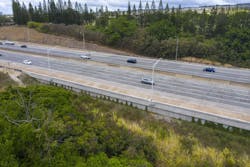The H-1 Freeway in Oahu is the busiest roadway in the state of Hawaii. In 2019, the Hawaii Department of Transportation completed improvements to H-1 through Pearl City, about 10 miles northwest of Honolulu. The roadway surface was replaced with new pavement, and the shoulder lanes were widened. Two Reinforced Earth mechanically stabilized earth (MSE) walls were installed along the highway on the existing slope to widen the road.
Both walls are 10 ft tall from foundation to roadway grade. Each wall added a length of highway shoulder about 500 ft long. The walls were built using concrete panel facing, steel soil reinforcements, and lightweight cellular concrete (LCC) for backfill.
The existing foundation had bearing and settlement limitations. Even though the proposed walls were not significantly tall, a new MSE wall filling in the existing slope using granular soil or crushed stone backfill material would create too heavy of a new load for the foundation. Either the wall volume would have to be below a certain weight, or else the foundation would need improvement prior to installation of the wall.
To optimize project schedule and cost, the contractor, Kiewit, considered factors such as the size of the walls, material availability, and installation speed. RECo’s engineering department did a calculation to show that the weight of the MSE wall volume with LCC would be less than the original weight on the foundation with the original slope. Ultimately, the lightweight backfill option was chosen, using Cell-Crete. The LCC material, with a unit weight of 36 lb per cubic ft, is about 70% lighter weight than typical select granular backfill.
Using LCC for backfill requires a modified MSE installation process. A conventional MSE wall is built by repeating the process of compacting lifts of backfill, laying soil reinforcement on top of the fill, then compacting more fill on top. However, LCC is poured as a liquid and requires that the soil reinforcements be located in the middle of a lift rather than at a joint in the LCC lifts. This means that the soil reinforcements are supported off the ground using rebar stakes to make sure the LCC flows below and above the soil reinforcements. Other measures must be taken to contain the LCC liquid pour, which is not necessary when using granular backfill. Once the LCC cures, it results in a lightweight wall mass.
The use of lightweight cellular concrete for MSE backfill is becoming more common across the country as a solution for weak foundations, or even simply for project constructability. In the case of the H-1 Freeway widening, it proved to be the best alternative to produce a new lightweight embankment with the strength to carry the highest volume of traffic in Hawaii.
Editor's Note: Scranton Gillette Communications and the SGC Infrastructure Group are not liable for the accuracy, efficacy and validity of the claims made in this piece. The views expressed in this content do not reflect the position of the Roads & Bridges' Editorial Team.

